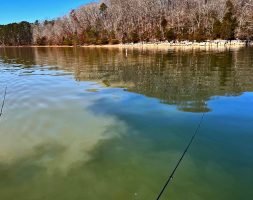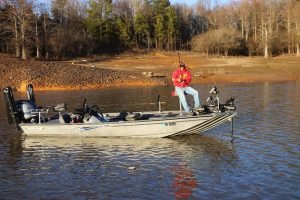Crappie actually cannot see any better than you can in muddy water. However, they have
highly developed sensory organs you don’t have. And those organs lead them to food,
or to your lures or bait. (Photo: Ron Wong)
Muddy Water Won’t Stop Your Crappie-Catching
by Ron Wong
It is true – April showers bring May flowers. But those rains also mean your favorite crappie fishing water might turn to chocolate milk.
Lots of lakes experience lower water levels in the winter, exposing a lot of mud banks. That means when it rains, they muddy up quickly. Or the muddy water will flow from the creeks into the lakes. When it’s really bad, there may only be one or two inches of visibility. How it the world can a crappie find a lure, or even a minnow, in that kind of water?
Trust us – they can!

Crappie really cannot see in muddy water any better than you can. What they have, however, are highly-developed sensory organs.
The lateral line running down each side basically works like radar, helping fish “feel” and literally home in on anything moving in the water in close proximity.
The also have nostrils, also called nares, just like you do. But their nares don’t open into their throat like yours do. They direct water into a chamber that contains sensory pads. They have an extremely good sense of smell that works at surprising distances. That’s why some say scent products, or live minnows, can be more helpful in muddy water. Coupled with their lateral lines, their sense of smell directs them toward food even in extremely muddy water.
Add to the fact that muddy water actually absorbs the warmth of the sun faster than clear water. As the water begins to warm and rise, crappie will be moving from the lake deep areas to ledges and creek mouths. And often crappie will be suspended higher in the water column. You may be sitting in 15 to 20-feet of water, but the fish that will bite will be only 4-6 feet deep.
Clay Blair, a professional crappie fisherman and guide on the North Mississippi lakes likes to use a bright colored bait like an orange & chartreuse Crappie Magnet with a pink colored 1/8th ounce jighead. He will look for bait fish first then start fishing and usually no more than 5-6 feet deep.
Steve Coleman has won eight crappie fishing world championships and now mostly guides on Tennessee’s Reelfoot Lake. He likes to use a double-minnow rig in muddy water. The lowest minnow will only be 5-6 feet deep over deeper water. He recommends moving slowly – no more than 0.4 mph. Small minnows work the best as that is what the crappie will be eating.

Once the water warms to 55-60 degrees, they will be moving into the creeks and shallows following bait fish and preparing to spawn. Although the water will still be muddy and there will be lots of trash along the banks, the bait fish and crappie will move with the warming water.
The northeast areas of lakes are best to target as the water warms quicker. Both Blair and Coleman prefer to vertical jig recently flooded bushes and timber as they will provide a little warmer water. Again, the crappie will be in the upper portion of the water column, you may be sitting in 5-6 feet of water, but the biting fish will be 2-4 feet deep.
And because the crappies that are moving shallower to prepare for the spawn, they will eat a bigger bait such as Crappie Magnet Slab Magnet, Bobby Garland Slab Slay’R or Strike King Joker.
These all should be in a bright color, like electric chicken or black & chartreuse. A black 1/16th ounce hair jig tipped with a small minnow will work well especially on a cold-front day in muddy water.
Another tip the pros shared about fishing rising muddy water in creeks and coves – do not go shallower with the rising water. If the fish were in 3 feet of water and the water has risen a foot over a day, stay in the 4 feet of water as the fish do not like a lot of fresh water. This is applicable to areas with cover.

Here are some tips that our pros gave for fishing dirty water:
- Use an attractant like Bobby Garland Mo’ Glow Slab Jam or Crappie Magnet Slab Bites
- Fish slow, leave your offering in one place for a period of time
- Scents, or live minnows, may be more helpful in muddy water than when the water is clear
- Follow watercolor change lines, muddy meets clearing water, fish the edge (as there will be less fresh water)
- In shallow water, fish cover like timber and bushes (if fishing during a cold front, fish the middle of the bushes)
- Fish sandy banks as the water will be less stained
- Fish vegetation if any is present, as it will filter the water and be a little clearer
- Use bright colored jig heads such as pink or orange
- Do not shake your offering very much, let the crappie find your bait
- Look for birds and seagulls to locate baitfish
- Use a longer fishing rod like a B’n’M 14-foot Blue Diamond or 16-foot BGJP, will help to reduce chance of spooking fish
So don’t let those heavy rains and muddy water scare you off the lake. Crappie can be caught in dirty water.
Ron Wong attended Memphis State University (now U of M) on a music scholarship playing saxophone. He spent four years in the U.S. Navy, retired from FedEx after 34 years. An avid fisherman and journalist, Wong co-hosts the weekly radio show Outdoors with Larry Rea which airs on Saturday mornings from 6-7:30 a.m. on ESPN790.


